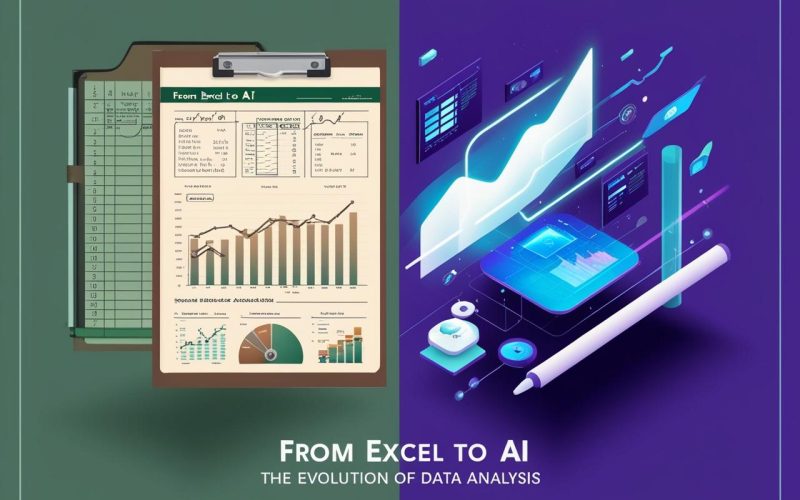Data is considered the new oil. It fuels business decisions, drives innovation, and helps organizations stay ahead of the competition. However, the journey of analyzing this data, from simple spreadsheets to powerful artificial intelligence (AI) systems, has been nothing short of revolutionary. Data analysis’s evolution reflects advancements in technology and a fundamental shift in how businesses perceive and utilize data.
In this article, we will explore the progression of data analysis tools and methods, beginning with Excel and leading to the latest in AI-driven analytics. We’ll also touch upon how professionals can upskill themselves for this transformative journey with resources like a data analytics training course in Noida.
1. The Early Days: Data Analysis with Excel
Before cloud computing, machine learning, and big data became everyday terms, Excel reigned as the go-to tool for data analysis. Developed by Microsoft and released in 1985, Excel became synonymous with data crunching, budgeting, and basic reporting.
Key Features of Excel for Data Analysis:
- Formulas and Functions: Excel provided powerful built-in functions like SUM(), VLOOKUP(), IF(), and AVERAGE() that allowed users to quickly perform basic mathematical and logical operations.
- Pivot Tables: These were a game-changer in organizing and summarizing large datasets without complex coding.
- Charts and Graphs: Data visualization became more accessible, making it easier to identify trends and patterns.
Despite its power, Excel had limitations in handling large datasets, real-time analysis, and predictive modeling. This led analysts to seek more advanced solutions.
2. The Rise of Structured Query Language (SQL)
As databases became more complex and business data started to grow exponentially, tools like SQL (Structured Query Language) came into play. SQL enabled analysts to interact directly with relational databases, offering far more flexibility and control over data compared to Excel.
SQL Strengths:
- Ability to handle larger datasets efficiently
- Enhanced querying capabilities
- Integration with other software for advanced analytics
SQL became a must-know skill for data professionals, forming a bridge between traditional spreadsheet users and the next generation of data scientists.
3. The Statistical Shift: R and Python
With the growth of statistical analysis and academic research in the late 1990s and early 2000s, programming languages like R and Python gained popularity.
Why R?
- Specifically designed for statistical computing
- Rich ecosystem of libraries like ggplot2, dplyr, and caret
- Excellent for hypothesis testing, regression analysis, and data visualization
Why Python?
- General-purpose programming with a data science twist
- Extensive libraries like pandas, NumPy, scikit-learn, and matplotlib
- Easier learning curve for beginners compared to R
Both R and Python introduced a new dimension of data analysis: reproducibility, automation, and scalability. Analysts could now build models, run simulations, and create data pipelines that were simply impossible with Excel.
4. The Era of Business Intelligence (BI) Tools
As businesses started dealing with multi-dimensional data coming from various sources—web, mobile, CRM systems, etc.—there was a demand for tools that could offer real-time insights, interactivity, and ease of use. Enter BI tools like Tableau, Power BI, and QlikView.
Key Advantages:
- Drag-and-drop interfaces
- Real-time dashboards and KPIs
- Connectivity with multiple data sources
- Advanced visual storytelling
- BI tools made it easier for non-technical users to access and interpret data, fostering a data-driven culture across organizations.
5. Big Data Analytics: Handling the Volume, Velocity, and Variety
Traditional data analysis tools started to struggle with the 3Vs of Big Data—Volume, Velocity, and Variety. This led to the emergence of new frameworks and technologies designed specifically for handling massive datasets.
Tools and Frameworks:
- Hadoop: A distributed storage and processing framework
- Spark: In-memory processing for faster computation
- Kafka: Real-time data streaming
Big Data analytics allowed businesses to not only store and manage large volumes of data but also derive actionable insights from it. Real-time fraud detection, recommendation engines, and customer behavior analysis became possible on a massive scale.
6. Machine Learning: The Leap from Descriptive to Predictive Analytics
With machine learning (ML), data analysis has evolved from merely describing past events to predicting future outcomes. ML algorithms use historical data to find patterns and make predictions without being explicitly programmed.
Popular Machine Learning Models:
- Linear Regression: For continuous variable prediction
- Classification Algorithms: Such as Decision Trees, Random Forests, and Support Vector Machines
- Clustering Algorithms: Like K-means and Hierarchical clustering for segmenting data
- Deep Learning: Neural networks that mimic the human brain, ideal for image, speech, and text data
Machine learning unlocked new capabilities like personalized marketing, churn prediction, and advanced risk assessment.
7. Artificial Intelligence and Automated Analytics
AI represents the most advanced stage of data analysis so far. While machine learning is a subset of AI, modern AI systems go a step further—they not only predict outcomes but also recommend actions.
AI in Action:
- Natural Language Processing (NLP): Allows systems to understand and generate human language (e.g., chatbots, sentiment analysis)
- Computer Vision: AI models that analyze images and videos
- Reinforcement Learning: Algorithms that learn optimal behaviors through trial and error
Moreover, Automated Machine Learning (AutoML) platforms are making AI accessible to non-experts by automating model selection, tuning, and evaluation.
8. Cloud Computing and Data Democratization
Cloud platforms like AWS, Google Cloud, and Azure have made it possible for even small businesses to harness the power of AI and big data without investing in expensive infrastructure.
Benefits of Cloud-Based Analytics:
- Scalable computing resources
- Cost-effective storage
- Easy integration with analytics tools
- Collaboration from anywhere
This shift has made data analysis more inclusive and widespread, fueling a new wave of digital transformation.
9. The Role of Data Governance and Ethics
As the power of data analysis grows, so does the responsibility. With tools that can influence financial markets, political campaigns, and even healthcare outcomes, it is crucial to address:
- Bias in AI models
- Data privacy regulations like GDPR and HIPAA
- Transparent and explainable AI
Responsible data practices ensure that technology benefits society without causing harm or reinforcing inequality.
10. Preparing for the Future of Data Analysis
The rapid evolution of data analysis underscores the ne ed for continuous learning. Professionals must stay updated with new tools, languages, and frameworks. Whether you’re starting your journey or looking to specialize in AI and ML, structured learning programs can help.
For example, enrolling in a best data analytics training course in Delhi, Lucknow, Meerut, Chennai, and more cities in India can equip learners with hands-on skills in Python, SQL, Tableau, machine learning, and more, preparing them to thrive in today’s competitive data-driven job market.
Conclusion
From simple Excel sheets to sophisticated AI systems, the evolution of data analysis has redefined how we interpret the world around us. As each stage introduced new tools and capabilities, the core goal remained the same: to turn raw data into meaningful insights.
In the years to come, we can expect even more revolutionary changes, like quantum computing, augmented analytics, and AI-generated data insights. But regardless of the tools, the real power lies in the analyst’s ability to ask the right questions, interpret results responsibly, and drive informed decisions.
The future of data analysis is bright, and those who embrace continuous learning and innovation will lead the way.












